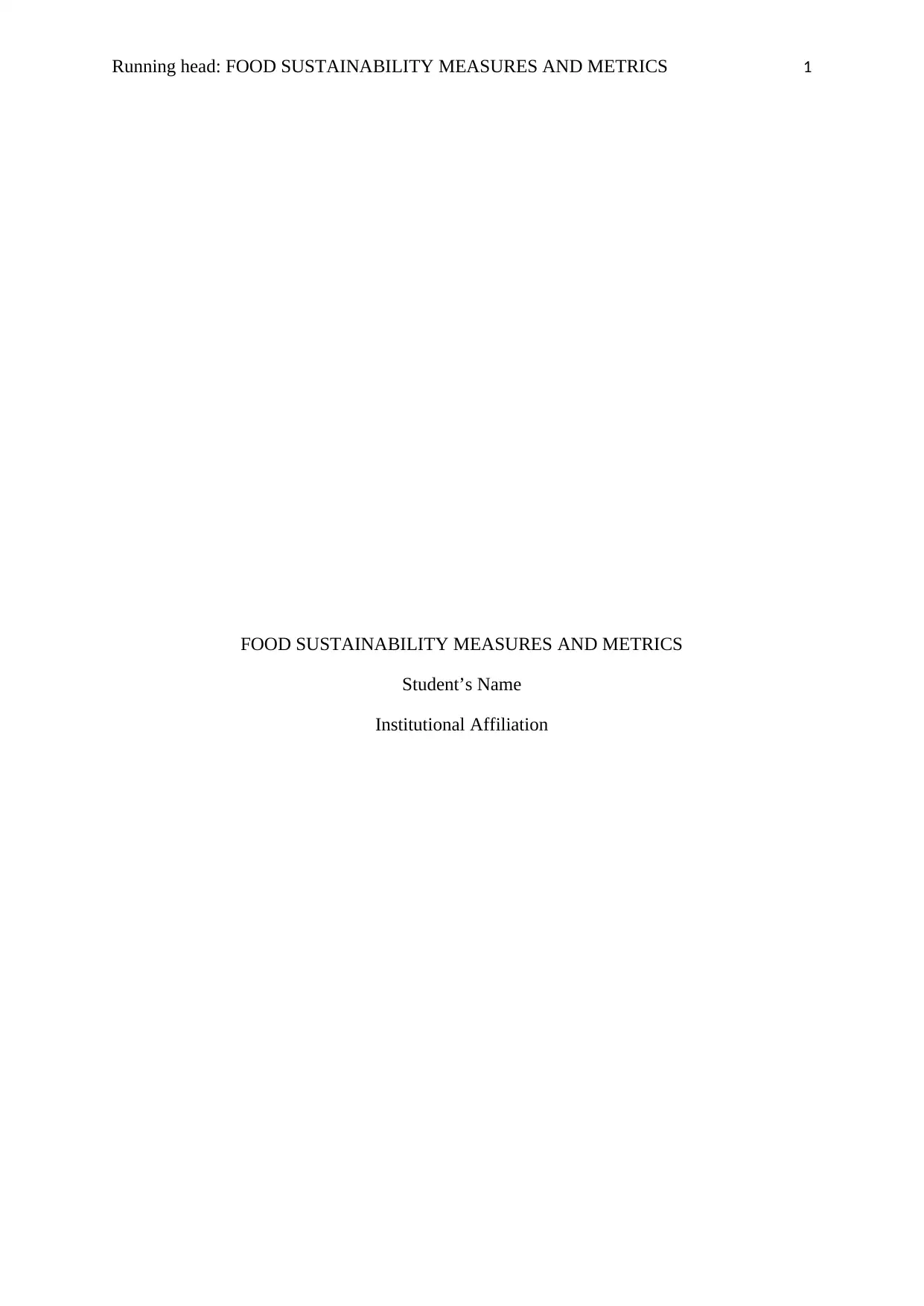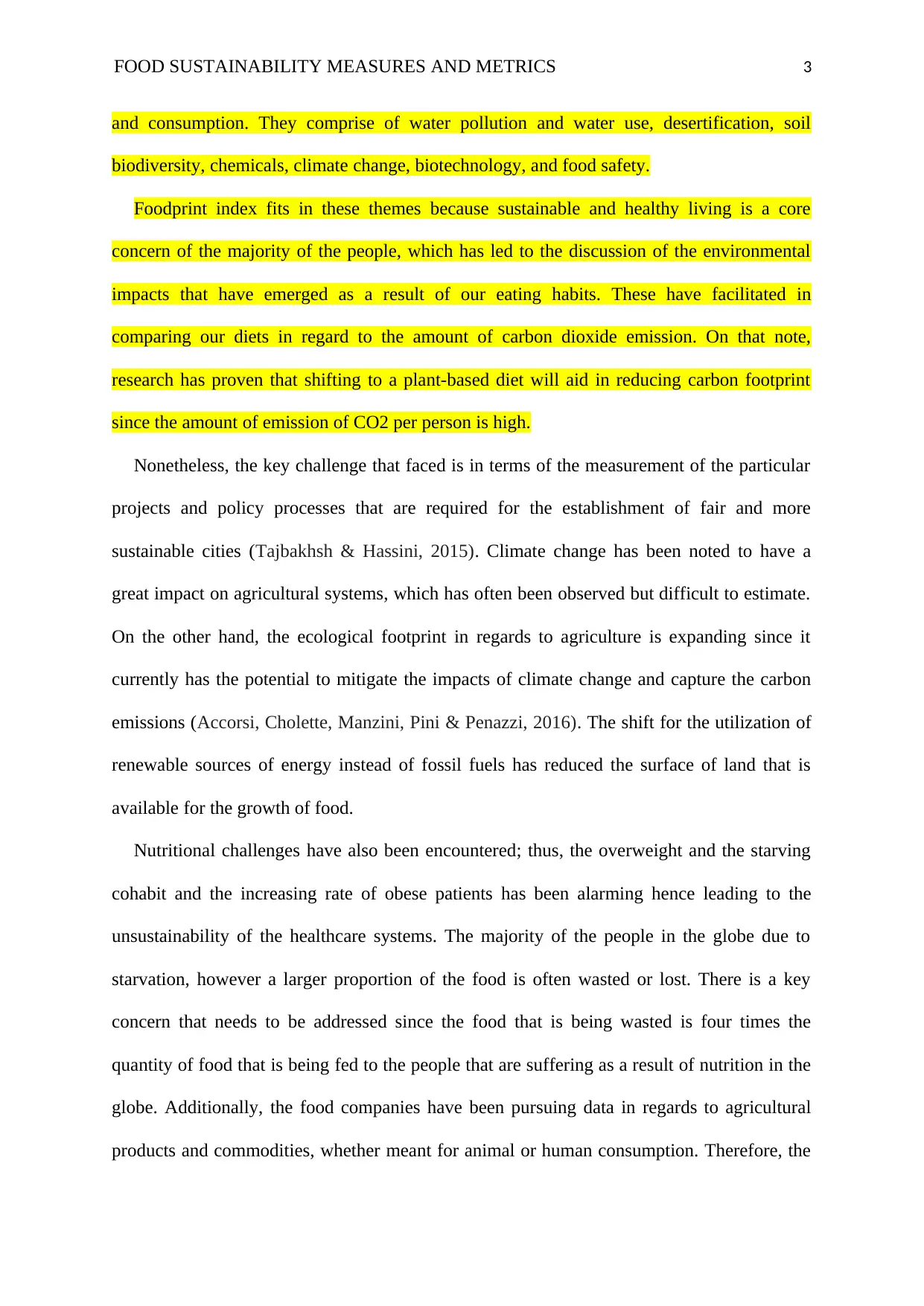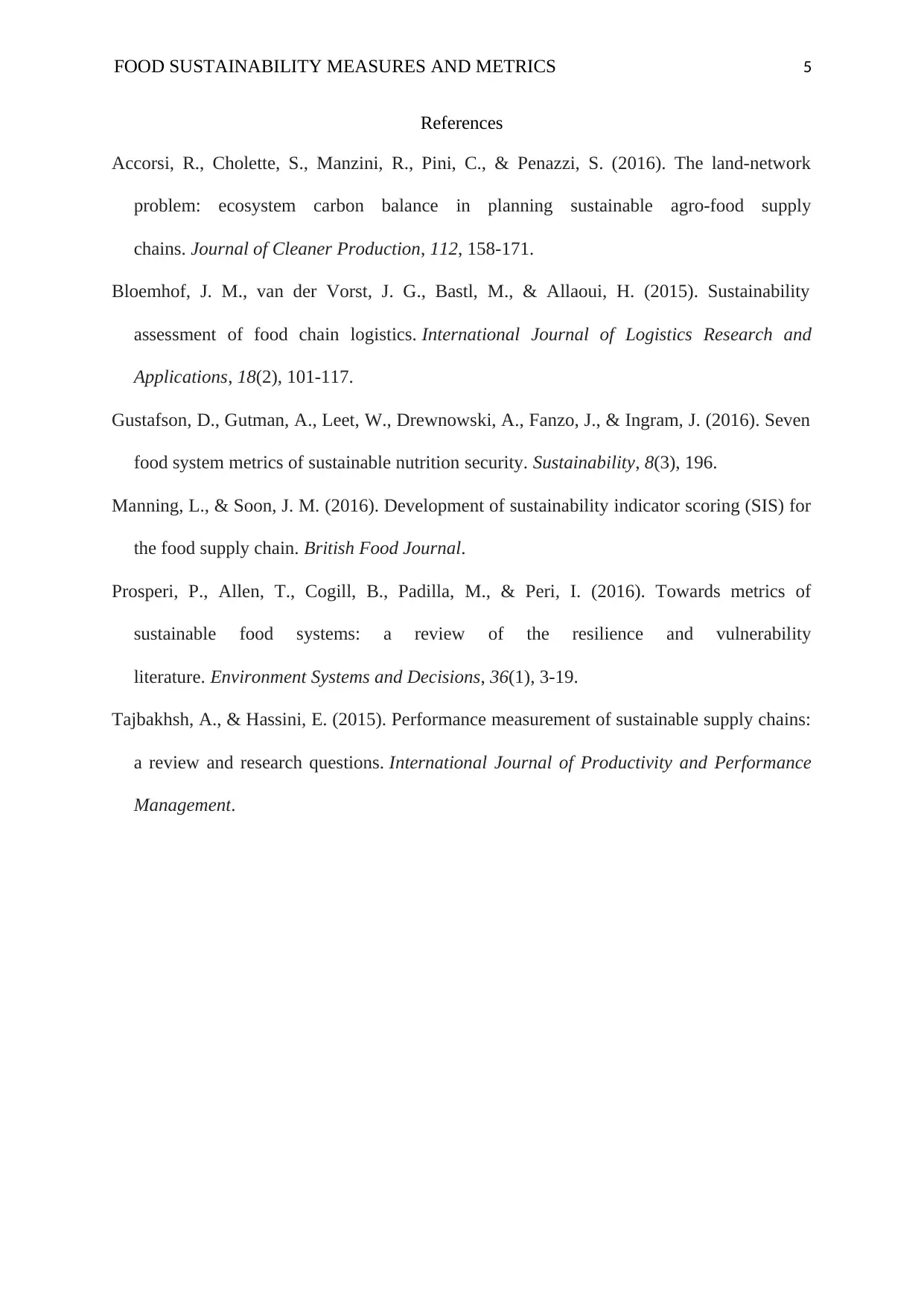Food Sustainability Measures And Metrices
VerifiedAdded on 2022/08/14
|5
|1415
|16
AI Summary
Contribute Materials
Your contribution can guide someone’s learning journey. Share your
documents today.

Running head: FOOD SUSTAINABILITY MEASURES AND METRICS 1
FOOD SUSTAINABILITY MEASURES AND METRICS
Student’s Name
Institutional Affiliation
FOOD SUSTAINABILITY MEASURES AND METRICS
Student’s Name
Institutional Affiliation
Secure Best Marks with AI Grader
Need help grading? Try our AI Grader for instant feedback on your assignments.

FOOD SUSTAINABILITY MEASURES AND METRICS 2
Food Sustainability Measures and Metrics
A sustainable food system is termed as an inclusive network that incorporates the majority
of the components in order to enhance the economic, community, and social wellbeing. It has
been established on the principles that further the social, ecological, and economic values of a
region and community. It is essential to take appropriate food security measures since it is
critical for economic aid and targeting food. In addition, it facilitates nutrition evaluation,
global monitoring systems, and the creation of programs that will inspire government policies
across various agricultural sectors. Similarly, it provides ecological stewardship and promotes
the quality of life of the majority of the families in the community. These will lead to the
high production of fiber necessities and human food.
The focal agenda of international institutions, governments, and practitioners around the
globe is to establish more sustainable cities. These can be achieved by ensuring that factors
such as global resource depletion, rapid urbanization, staggering socio-economic inequalities,
and climate changes have been put into consideration. Hence, the majority of the cities are
utilizing food as a tool of delivery in regards to social, health, environmental, and economic
benefits. This strategy is utilized as a channel for transforming the cities. On that note, food is
being utilized as a mechanism to bring together policymakers, civil societies, and the private
sector in order to establish an urban environment that is more reliable and sustainable.
Sustainable agriculture or food production focuses majorly on improving and maintaining
soil fertility, expansion of earth's natural resource, and protection of the environment
(Bloemhof, van der Vorst, Bastl, & Allaoui, 2015). On the other hand, the climate has an
impact on food sustainability; hence it can lead to high prices of food and reduction in food
supplies due to change in the rain patterns. The climatic changes threaten farmers due to a
long period of drought and flood, which will end up destroying the crops. In addition, there
are some of the environmental issues that have an impact on agricultural food sustainability
Food Sustainability Measures and Metrics
A sustainable food system is termed as an inclusive network that incorporates the majority
of the components in order to enhance the economic, community, and social wellbeing. It has
been established on the principles that further the social, ecological, and economic values of a
region and community. It is essential to take appropriate food security measures since it is
critical for economic aid and targeting food. In addition, it facilitates nutrition evaluation,
global monitoring systems, and the creation of programs that will inspire government policies
across various agricultural sectors. Similarly, it provides ecological stewardship and promotes
the quality of life of the majority of the families in the community. These will lead to the
high production of fiber necessities and human food.
The focal agenda of international institutions, governments, and practitioners around the
globe is to establish more sustainable cities. These can be achieved by ensuring that factors
such as global resource depletion, rapid urbanization, staggering socio-economic inequalities,
and climate changes have been put into consideration. Hence, the majority of the cities are
utilizing food as a tool of delivery in regards to social, health, environmental, and economic
benefits. This strategy is utilized as a channel for transforming the cities. On that note, food is
being utilized as a mechanism to bring together policymakers, civil societies, and the private
sector in order to establish an urban environment that is more reliable and sustainable.
Sustainable agriculture or food production focuses majorly on improving and maintaining
soil fertility, expansion of earth's natural resource, and protection of the environment
(Bloemhof, van der Vorst, Bastl, & Allaoui, 2015). On the other hand, the climate has an
impact on food sustainability; hence it can lead to high prices of food and reduction in food
supplies due to change in the rain patterns. The climatic changes threaten farmers due to a
long period of drought and flood, which will end up destroying the crops. In addition, there
are some of the environmental issues that have an impact on agricultural food sustainability

FOOD SUSTAINABILITY MEASURES AND METRICS 3
and consumption. They comprise of water pollution and water use, desertification, soil
biodiversity, chemicals, climate change, biotechnology, and food safety.
Foodprint index fits in these themes because sustainable and healthy living is a core
concern of the majority of the people, which has led to the discussion of the environmental
impacts that have emerged as a result of our eating habits. These have facilitated in
comparing our diets in regard to the amount of carbon dioxide emission. On that note,
research has proven that shifting to a plant-based diet will aid in reducing carbon footprint
since the amount of emission of CO2 per person is high.
Nonetheless, the key challenge that faced is in terms of the measurement of the particular
projects and policy processes that are required for the establishment of fair and more
sustainable cities (Tajbakhsh & Hassini, 2015). Climate change has been noted to have a
great impact on agricultural systems, which has often been observed but difficult to estimate.
On the other hand, the ecological footprint in regards to agriculture is expanding since it
currently has the potential to mitigate the impacts of climate change and capture the carbon
emissions (Accorsi, Cholette, Manzini, Pini & Penazzi, 2016). The shift for the utilization of
renewable sources of energy instead of fossil fuels has reduced the surface of land that is
available for the growth of food.
Nutritional challenges have also been encountered; thus, the overweight and the starving
cohabit and the increasing rate of obese patients has been alarming hence leading to the
unsustainability of the healthcare systems. The majority of the people in the globe due to
starvation, however a larger proportion of the food is often wasted or lost. There is a key
concern that needs to be addressed since the food that is being wasted is four times the
quantity of food that is being fed to the people that are suffering as a result of nutrition in the
globe. Additionally, the food companies have been pursuing data in regards to agricultural
products and commodities, whether meant for animal or human consumption. Therefore, the
and consumption. They comprise of water pollution and water use, desertification, soil
biodiversity, chemicals, climate change, biotechnology, and food safety.
Foodprint index fits in these themes because sustainable and healthy living is a core
concern of the majority of the people, which has led to the discussion of the environmental
impacts that have emerged as a result of our eating habits. These have facilitated in
comparing our diets in regard to the amount of carbon dioxide emission. On that note,
research has proven that shifting to a plant-based diet will aid in reducing carbon footprint
since the amount of emission of CO2 per person is high.
Nonetheless, the key challenge that faced is in terms of the measurement of the particular
projects and policy processes that are required for the establishment of fair and more
sustainable cities (Tajbakhsh & Hassini, 2015). Climate change has been noted to have a
great impact on agricultural systems, which has often been observed but difficult to estimate.
On the other hand, the ecological footprint in regards to agriculture is expanding since it
currently has the potential to mitigate the impacts of climate change and capture the carbon
emissions (Accorsi, Cholette, Manzini, Pini & Penazzi, 2016). The shift for the utilization of
renewable sources of energy instead of fossil fuels has reduced the surface of land that is
available for the growth of food.
Nutritional challenges have also been encountered; thus, the overweight and the starving
cohabit and the increasing rate of obese patients has been alarming hence leading to the
unsustainability of the healthcare systems. The majority of the people in the globe due to
starvation, however a larger proportion of the food is often wasted or lost. There is a key
concern that needs to be addressed since the food that is being wasted is four times the
quantity of food that is being fed to the people that are suffering as a result of nutrition in the
globe. Additionally, the food companies have been pursuing data in regards to agricultural
products and commodities, whether meant for animal or human consumption. Therefore, the

FOOD SUSTAINABILITY MEASURES AND METRICS 4
opportunities and challenges in regards to food metric data collection apply to both the
ranchers and farmers. The terminology data is often utilized to refer to the information and
measurement that is collected on the farm through varying criteria, which can be through use
agricultural tools, sensors, and other methods or technology. On the other hand, the term
metric is used to refer to the output application process in regards to certain methodologies
and calculations towards information and measurement (Prosperi, Allen, Cogill, Padilla &
Peri, 2016). On that note, the metrics can refer to the indicators and be numeric (Manning &
Soon, 2016).
In conclusion, it is evident that extreme weather, climate change, and dwindling natural
resource display core challenges for food systems in order to meet the international demands
in a way that it will both comply to the planetary constraints and meet the human nutrition
desires. On that note, the food system metrics has provided us with the opportunity at first
hand to accurately and holistically be able to measure the performance of the food systems
across all the necessary spheres of interest such as the environment, nutrition, social,
economic, safety, resilience and waste (Gustafson et al., 2016). The current methodology
permits the quantification of sustainable nutrition security (SNS), which is a strategy that can
be implemented by the investors and decision-makers to set track progress and significant
goals on SDG. This will aid in the examination of the potential impact of food systems
intervention, which is intended to enhance both the planetary and human health. Therefore,
metrics can be applied in both less and highly developed countries. Metrics application at the
national scale level has practical utility at a lesser geographical scale. On the other hand, the
insufficiency of data in some of the nations does indicate a lack of policy monitoring, thus
emphasizing the regions of action.
opportunities and challenges in regards to food metric data collection apply to both the
ranchers and farmers. The terminology data is often utilized to refer to the information and
measurement that is collected on the farm through varying criteria, which can be through use
agricultural tools, sensors, and other methods or technology. On the other hand, the term
metric is used to refer to the output application process in regards to certain methodologies
and calculations towards information and measurement (Prosperi, Allen, Cogill, Padilla &
Peri, 2016). On that note, the metrics can refer to the indicators and be numeric (Manning &
Soon, 2016).
In conclusion, it is evident that extreme weather, climate change, and dwindling natural
resource display core challenges for food systems in order to meet the international demands
in a way that it will both comply to the planetary constraints and meet the human nutrition
desires. On that note, the food system metrics has provided us with the opportunity at first
hand to accurately and holistically be able to measure the performance of the food systems
across all the necessary spheres of interest such as the environment, nutrition, social,
economic, safety, resilience and waste (Gustafson et al., 2016). The current methodology
permits the quantification of sustainable nutrition security (SNS), which is a strategy that can
be implemented by the investors and decision-makers to set track progress and significant
goals on SDG. This will aid in the examination of the potential impact of food systems
intervention, which is intended to enhance both the planetary and human health. Therefore,
metrics can be applied in both less and highly developed countries. Metrics application at the
national scale level has practical utility at a lesser geographical scale. On the other hand, the
insufficiency of data in some of the nations does indicate a lack of policy monitoring, thus
emphasizing the regions of action.
Secure Best Marks with AI Grader
Need help grading? Try our AI Grader for instant feedback on your assignments.

FOOD SUSTAINABILITY MEASURES AND METRICS 5
References
Accorsi, R., Cholette, S., Manzini, R., Pini, C., & Penazzi, S. (2016). The land-network
problem: ecosystem carbon balance in planning sustainable agro-food supply
chains. Journal of Cleaner Production, 112, 158-171.
Bloemhof, J. M., van der Vorst, J. G., Bastl, M., & Allaoui, H. (2015). Sustainability
assessment of food chain logistics. International Journal of Logistics Research and
Applications, 18(2), 101-117.
Gustafson, D., Gutman, A., Leet, W., Drewnowski, A., Fanzo, J., & Ingram, J. (2016). Seven
food system metrics of sustainable nutrition security. Sustainability, 8(3), 196.
Manning, L., & Soon, J. M. (2016). Development of sustainability indicator scoring (SIS) for
the food supply chain. British Food Journal.
Prosperi, P., Allen, T., Cogill, B., Padilla, M., & Peri, I. (2016). Towards metrics of
sustainable food systems: a review of the resilience and vulnerability
literature. Environment Systems and Decisions, 36(1), 3-19.
Tajbakhsh, A., & Hassini, E. (2015). Performance measurement of sustainable supply chains:
a review and research questions. International Journal of Productivity and Performance
Management.
References
Accorsi, R., Cholette, S., Manzini, R., Pini, C., & Penazzi, S. (2016). The land-network
problem: ecosystem carbon balance in planning sustainable agro-food supply
chains. Journal of Cleaner Production, 112, 158-171.
Bloemhof, J. M., van der Vorst, J. G., Bastl, M., & Allaoui, H. (2015). Sustainability
assessment of food chain logistics. International Journal of Logistics Research and
Applications, 18(2), 101-117.
Gustafson, D., Gutman, A., Leet, W., Drewnowski, A., Fanzo, J., & Ingram, J. (2016). Seven
food system metrics of sustainable nutrition security. Sustainability, 8(3), 196.
Manning, L., & Soon, J. M. (2016). Development of sustainability indicator scoring (SIS) for
the food supply chain. British Food Journal.
Prosperi, P., Allen, T., Cogill, B., Padilla, M., & Peri, I. (2016). Towards metrics of
sustainable food systems: a review of the resilience and vulnerability
literature. Environment Systems and Decisions, 36(1), 3-19.
Tajbakhsh, A., & Hassini, E. (2015). Performance measurement of sustainable supply chains:
a review and research questions. International Journal of Productivity and Performance
Management.
1 out of 5
Related Documents
Your All-in-One AI-Powered Toolkit for Academic Success.
+13062052269
info@desklib.com
Available 24*7 on WhatsApp / Email
![[object Object]](/_next/static/media/star-bottom.7253800d.svg)
Unlock your academic potential
© 2024 | Zucol Services PVT LTD | All rights reserved.





